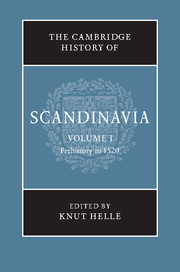Book contents
- Frontmatter
- Introduction
- PART I THE GEOGRAPHY AND PREHISTORY OF SCANDINAVIA
- PART II FROM VIKINGS TO KINGS
- 5 The Viking expansion
- 6 Viking culture
- 7 Scandinavia enters Christian Europe
- 8 Early political organisation
- (a) Introductory survey
- (b) The making of the Danish kingdom
- (c) The early unification of Norway
- (d) The Norse island communities of the Western Ocean
- (e) Kings and provinces in Sweden
- PART III MATERIAL GROWTH (to c. 1350)
- PART IV THE HIGH MEDIEVAL KINGDOMS
- PART V HIGH AND LATE MEDIEVAL CULTURE
- PART VI LATE MEDIEVAL SOCIETY (c. 1350–1520)
- PART VII SCANDINAVIAN UNIONS (1319–1520)
- Conclusion
- Select bibliography: primary sources, general surveys and secondary works arranged by part
- Index
- Plate Section"
- References
(c) - The early unification of Norway
from 8 - Early political organisation
Published online by Cambridge University Press: 28 March 2008
- Frontmatter
- Introduction
- PART I THE GEOGRAPHY AND PREHISTORY OF SCANDINAVIA
- PART II FROM VIKINGS TO KINGS
- 5 The Viking expansion
- 6 Viking culture
- 7 Scandinavia enters Christian Europe
- 8 Early political organisation
- (a) Introductory survey
- (b) The making of the Danish kingdom
- (c) The early unification of Norway
- (d) The Norse island communities of the Western Ocean
- (e) Kings and provinces in Sweden
- PART III MATERIAL GROWTH (to c. 1350)
- PART IV THE HIGH MEDIEVAL KINGDOMS
- PART V HIGH AND LATE MEDIEVAL CULTURE
- PART VI LATE MEDIEVAL SOCIETY (c. 1350–1520)
- PART VII SCANDINAVIAN UNIONS (1319–1520)
- Conclusion
- Select bibliography: primary sources, general surveys and secondary works arranged by part
- Index
- Plate Section"
- References
Summary
The political history of Norway in the Viking Age and the early Scandinavian Middle Ages has been dominated by one great theme, the political unification (Norw. rikssamling) of the different parts of the country into one kingdom. With this as their perspective Norwegian historians have been working on the period’s history for more than 150 years. Most of them have agreed that the unification process did not gain real momentum until the beginning of the eleventh century. Already in the 1850s P. A. Munch (1810–63), one of the founding fathers of modern Norwegian historiography, maintained that ‘a new chapter of Norwegian history’ could begin only ‘after the complete Christianisation and the elimination of the last remnants of Danish rule in Norway’.
At the same time many historians have regarded events both of the ninth and tenth centuries as being decisive for the political consolidation of Norwegian territory. In the social development of the Viking Age, or even earlier periods, they have seen certain determining factors at work which made the unification of Norway natural or almost inevitable. Accordingly the historians of the last two generations have generally laid less stress on historical events and described the unification primarily as a ‘social process’. This has implied a deterministic view that is not totally misleading for the period after 1035 when strong forces were working in the same direction. But in the preceding period a wide range of possibilities were open and determinism tends to obscure the fact that for a long time Danish kings made their presence felt in south Norway (see Chapter 8(c)).
Keywords
- Type
- Chapter
- Information
- The Cambridge History of Scandinavia , pp. 184 - 201Publisher: Cambridge University PressPrint publication year: 2003
References
- 5
- Cited by

